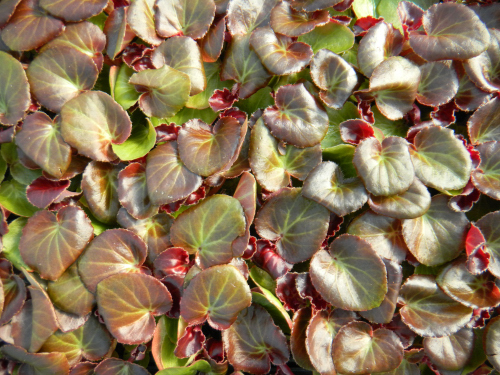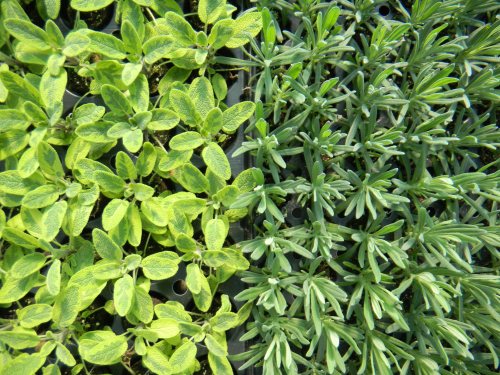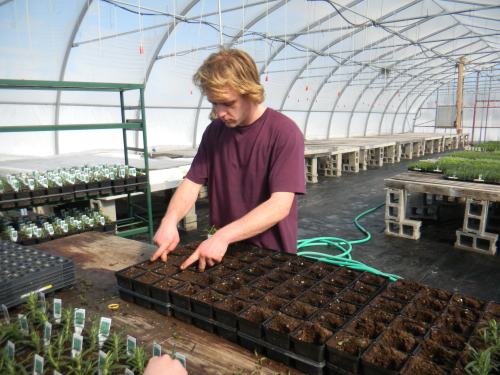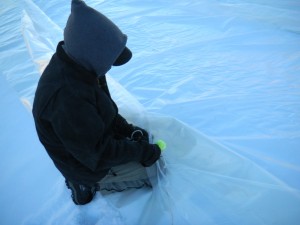This week we’re featuring one of our best deals yet: Buy one large planter, get one free! If you need some late season color for the porch or patio, we’ve got you covered with vining hanging baskets, gorgeous sap bucket planters, and locally made apple crates from our neighbors at Clifford Lumber that are overflowing with blooms.
Our friend and retail staff member Hope Johnson is to thank for designing many of our annual combinations. Hope brings a keen eye and a mastery of color and form to everything she does, whether it’s arranging planters or designing her stunning bee quilts. We’re lucky to have an artist like Hope on our team.
Below is a list of the many containers we have available. Prices range between $15.99 and $60, so finding symmetry in your patio garden is particularly economical this week!
Thunbergia: Also known as Black-eyed Susan Vine, with pops of butter yellow and orange flowers that peek out from draping foliage. Place in a hot, sunny spot where it can trellis along a fence or drape down from the hanging basket.
Mandevilla: A tropical plant with bold pink blooms that we eagerly anticipate every summer. These plants love the heat, but can also be brought indoors to overwinter.
Passionflower: We have two varieties of this stunning vine- “Aphrodite’s Nightie'‘ + “Blue Bahama”. Both will produce lush climbing foliage and totally unique blooms through the summer and fall. And did you know it has a calming effect when used as a tea herb?
Lophospermum: This year we are finally carrying this sweet flowering vine in “Wine Red” and it could not be easier to grow. Just place the basket in part to full sun and enjoy the burgundy flowers all season long.
Nasturtium: A kid favorite! Edible flowers and leaves cascade out of these sweet baskets. Infuse into vinegar for a spicy salad dressing, or pickle the seed pods for a highly local take on capers.
Herb Trios: 12” oval pots that feature mixed basil varieties and classic culinary herbs. Bring to your next potluck and place in the center of the table for on-demand garnishes.
Tomato Buckets: Trellised in 3 gallon pots, these tomatoes are great for patio snacking or adding some additional cherry tomato varieties to your collection. For folks who are summering in Vermont, they also offer a late planting opportunity.
Shade Baskets: If you’re working with part to full shade, fear not. Our fiber baskets are full of sturdy foliage and flowers that look good through the season. Our friends at Stone Soup fill their awning with them every year for long-lasting color and texture.
Sap Buckets and Apple Crates: These make wonderful gifts, as they come ready to display and provide cut flower options close by when placed near an entrance or by the kitchen door. This week, you can find the perfect one for a friend- and get one free to keep for yourself.
Passionflower “Blue Bahama”
In the Garden
Have you been cutting back your annual flowers? While it’s important to leave some blossoms for the pollinators to enjoy, cutting annual flowers prolongs their bloom time and provides you with fresh backyard bouquets every day. Additionally, flowers that have been pollinated tend not to last nearly as long in a vase as those that are cut before the insects find them. Now is a good time to scan your cutting garden and prune back any spent flower heads or those that have gone to seed- think of it as a haircut for your garden.
With all the rain we’ve been getting, it’s a good idea to add fertility to your flowers and vegetables now, especially if you have loamy or sandy soil. We like to use Vermont Compost Company’s Compost Plus for gentle, long-lasting feedings that will keep the produce and flowers in peak production.
As always, our retail greenhouses are open from 8-6 every day, and we’re happy to answer questions and help you find your new favorite plants. You can join us in person on August 5th for our free First Thursday event; this month Chad will be talking about pests and diseases of the home garden.
Happy gardening,
Sophie
P.S. If your kitchen ambitions are larger than what your garden can provide, we have bulk fresh herbs available to purchase: Use the secret code BASIL for $5 off your order of Sweet Genovese Basil.





















